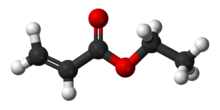Ethyl acrylate

| |

| |
| Names | |
|---|---|
| IUPAC name
Ethyl propenoate
| |
| Other names
Acrylic acid ethyl ester
Ethyl propenoate | |
| Identifiers | |
3D model (JSmol)
|
|
| ChemSpider | |
| ECHA InfoCard | 100.004.945 |
| RTECS number |
|
| UNII | |
CompTox Dashboard (EPA)
|
|
| |
| |
| Properties | |
| C5H8O2 | |
| Molar mass | 100.11 |
| Appearance | Clear liquid |
| Density | 0.9405 g/mL |
| Melting point | -71 °C |
| Boiling point | 99.4 °C |
| Insoluble | |
| Hazards | |
| NFPA 704 (fire diamond) | |
| Flash point | 15 °C |
Except where otherwise noted, data are given for materials in their standard state (at 25 °C [77 °F], 100 kPa).
| |
Ethyl acrylate is an organic compound primarily used in the preparation of various polymers. It is a clear liquid with an acrid penetrating odor. The human nose is capable of detecting this odor at a thousand times lower concentration than is considered harmful if continuously exposed for some period of time. [3]
Chemistry
Ethyl acrylate can be prepared by several industrial methods. Acrylonitrile can be reacted with ethanol using sulfuric acid as a catalyst to produce ethyl acrylate. It may also be prepared from acetylene, carbon monoxide and ethanol.
Ethyl acrylate will readily polymerize upon standing and polymerization is accelerated by heat, light, and peroxides.
Uses
Ethyl acrylate is used in the production of polymers including resins, plastics, rubber, and denture material.[4]
Safety
Ethyl acrylate's main safety issue arises from its being flammable and highly reactive.
Although there are some reports claiming that ethyl acrylate is a carcinogen,[4] major respected bodies regard the evidence of human carcinogenicity as weak and/or inconsistent. The International Agency for Research on Cancer stated, "Overall evaluation, Ethyl acrylate is possibly carcinogenic to humans (Group 2B)."[5] The United States Environmental Protection Agency (EPA) states, "Human studies on occupational exposure to ethyl acrylate... have suggested a relationship between exposure to the chemical(s) and colorectal cancer, but the evidence is conflicting and inconclusive. In a study by the National Toxicology Program (NTP), increased incidences of squamous cell papillomas and carcinomas of the forestomach were observed in rats and mice exposed via gavage (experimentally placing the chemical in the stomach). However, the NTP recently determined that these data were not relevant to human carcinogenicity and removed ethyl acrylate from its list of carcinogens."[6] (Occupational exposure generally involves exposure that occurs regularly, over an extended period of time.)
Ethyl acrylate can irritate the nose, throat and lungs.
One favorable safety aspect is that ethyl acrylate has good warning properties; the odor threshold is much lower than any level of health concern. In other words, the bad odor warns people of ethyl acrylate's presence long before the concentration reaches a level capable of creating a serious health risk. Reports of the exact levels vary somewhat, but, for example, the U.S. E.P.A. reports an odor threshold of 0.0012 parts per million (ppm),[6] but the E.P.A.'s lowest level of health concern, the Acute Exposure Guideline Level-1 (AEGL-1) is 8.3 ppm,[7] which is almost 7000 times the odor threshold.
References
- ^ Merck Index, 11th Edition, 3715.
- ^ Ethyl acrylate Datasheet at Inchem.org
- ^ http://www.osha.gov/SLTC/healthguidelines/ethylacrylate/recognition.html#exposuresources
- ^ a b Ethyl acrylate Hazardous Substance Fact Sheet, New Jersey Department of Health and Senior Services
- ^ IARC Monographs on the Evaluation of Carcinogenic Risks to Humans, Volume 71, International Agency for Research on Cancer (1999)
- ^ a b EPA Technology Transfer Network, Air Toxics Web Site, United States Environmental Protection Agency (accessed 2008)
- ^ EPA Acute Exposure Guideline Levels, Ethyl acrylate Results, United States Environmental Protection Agency (accessed 2008)

